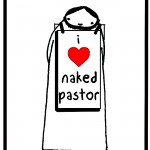The cartoon I posted this morning, “Exit Interview”, provoked quite a bit of discussion here and on Facebook.
Some took the side of the one leaving and even identified with him. So many people have had such negative experiences in choosing to leave a church. Some others took the side of the pastor who experiences hurt and disappointment and sometimes even anger when people leave his or her church. I’ve been on both sides and know the feelings of both.
I’ve thought a great deal about this kind of thing because it relates directly with how we do church and our attitudes toward it. I’ve spent a lot of time cartooning, writing and blogging about church, pastoring, and how to be a healthy community. In fact, I’ve written a book on it called “Without a Vision My People Prosper” (also available on Kindle).
I have 3 ideas that would help religious communities be healthier in today’s environment:
- fluidity: the religious community needs to be understood as fluid. Whoever wants to come can come and whoever wants to go can go. There are no expectations on level of commitment or even theological alignment. Like Jesus, his teaching style was very spontaneous, impromptu and voluntary. Even though some of the gospel stories reveal that that he experienced the pain of losing people, it didn’t cost his organization anything. It was free of an organization’s needs of security and longevity. Even when some declare deeper levels of commitment, they aren’t bound to it. Jesus was a pasture where people could go in and out and find pasture. Or not.
- unestablished: the religious community needs to discover new ways of existing without anchoring itself to institutional constructs. Even though Jesus had supporters (mostly women, by the way), and a treasurer, the fellowship could be dissolved at any moment. In fact, the walls that defined this fellowship were at times very porous, so that other individuals or groups somewhat theologically related or unrelated were not seen as opponents but as valid on their own merit. Not even Jesus wished to abolish the Sanhedrin but to call it to truth, or to eliminate Rome but to summon it to justice. His idea of the world was completely without walls.
- visionless: it is my claim that this is the most attractive but most insidious yeast undermining religious communities. Vision has a devious way of focusing our attention outside of ourselves to some lofty external goal, rather than keeping ourselves committed to love and service in the community, then as a result beyond the immediate community by the outpouring of the overflow. Jesus’ vision, if it could be said he had any vision at all, was to die… to hand himself over to the authorities, etc. Any other vision than the vision to be willing to die is one that decides who can play and who cannot for the longevity of the vision and it’s crafters. It defines the shape and nature of the community and the people within it, often with violence against the natural goodness and innate spirituality of its people. It is vision that eventually and inevitably changes an institution into stone.
For any existing community to adopt these three essentials is very unsettling and even destabilizing. Believe me, I know! But for any people desiring to start, these three would be good to keep in mind for starters.
Again, my book, “Without a Vision My People Prosper” (also available on Kindle), talks about this at length, with cartoons!











